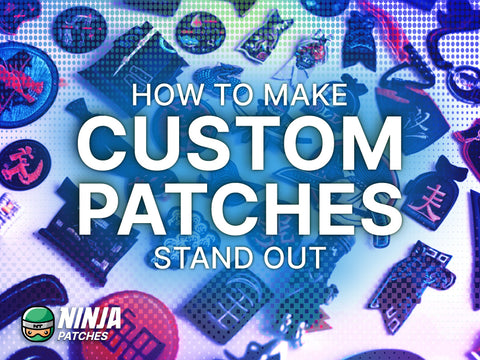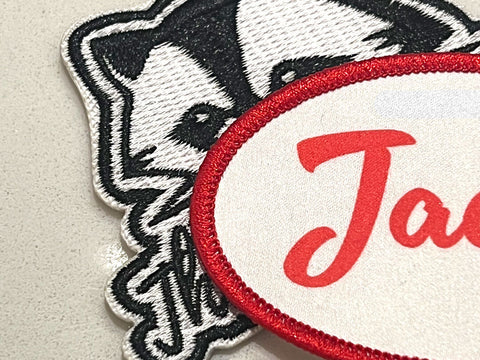Velcro patches have quickly become a popular accessory due to their versatility and ease of use. Used for various applications, from military and tactical gear to fashion and outdoor equipment, they are convenient and easy-to-apply options for customizing garments, accessories, and other items.
Whether you’re a hobbyist looking to add some embellishments to your gear, an outdoor enthusiast looking for patches that have unique functions, or simply interested in adding Velcro patches to your collection, we have everything you need to know right here.
In this guide, we’ll explore everything you need to know about Velcro patches, from what they are to how to use and care for them. Let’s dive in.
Table Of Contents
- What are Velcro patches?
- What types of patches come with Velcro backing?
- What are the main uses of Velcro patches?
- How to apply Velcro patches
- How to care for your Velcro patches
- Conclusion
What Are Velcro Patches?
The history of Velcro patches starts with the invention of Velcro by Swiss engineer George de Mestral in 1941. The inspiration came from a walk in the woods, where Mestral noticed how burrs clung to his clothes and his dog’s fur. When looking more closely at these burrs under a microscope, Mestral noticed how the burrs had tiny little hooks which caught on the fabric.
This led to the patent of the hook-and-loop fastener, which he named Velcro. Velcro has since been used for a wide variety of applications, from the aerospace industry to secure items at zero gravity to military use to attach patches to uniforms and gear. Velcro became widespread, and so did Velcro patches.
Over the decades, Velcro patches have become widespread in civilian life, used in everything from clothing and footwear to sports equipment and organizational tools. They’re well known for their convenience and adaptability and have become a staple in functional and decorative applications.
What Types Of Patches Come With A Velcro Backing?
We offer a wide range of patches that come with a Velcro backing for ease and convenience. These include chenille patches, full-color printed patches, PVC rubber patches, print & embroidered patches, woven patches, and embroidered patches.
What Are The Main Uses Of Velcro Patches?
Velcro patches are incredibly versatile, and their applications span various fields and purposes. Here are the primary uses of Velcro patches:
Clothing & Fashion Accessories
Velcro patches are popular in the fashion industry for their ease of use and customization capabilities. They can be easily attached to jackets, bags, hats, and other clothing items, allowing individuals to personalize their apparel. Fashion designers often use Velcro patches to add unique designs or brand logos to garments. Additionally, these patches can be swapped out effortlessly, enabling wearers to update their look without buying new clothes.
Military and Law Enforcement
Velcro patches are indispensable in military and law enforcement settings. They are used on uniforms to display rank insignia, unit identification, and other essential information. This system allows for quick changes and updates, ensuring that personnel can adjust their identifiers as needed. Velcro patches are also used for morale patches, which display motivational or humorous messages and symbols.
In emergency services, Velcro patches are used to identify roles and responsibilities quickly. Paramedics, firefighters, and rescue teams use these patches on their uniforms to display critical information such as medical qualifications, unit identifiers, and emergency response roles. This ensures that team members can be easily identified and can communicate their functions effectively during emergencies.
Sports & Outdoor Activities
Velcro patches play a significant role in sports and outdoor activities. Teams use them to mark equipment, display team logos, and identify players. For instance, sports uniforms often feature Velcro patches for player numbers and sponsor logos. In outdoor activities like hiking, camping, over landing and scouting, Velcro patches are used for identification and to attach essential items to gear, making them easily accessible. They can also be used for personalization.
Corporate and Organizational Branding
Businesses and organizations utilize Velcro patches for branding and promotional purposes. Custom patches with company logos and slogans can be attached to employee uniforms, promotional bags, and other merchandise. This not only enhances brand visibility but also creates a sense of unity and professionalism among employees. Velcro patches are also used at events and trade shows to promote brand identity.
Custom & Novelty Uses
Collectors and hobbyists find endless creative possibilities with Velcro patches. They can design unique patches to reflect personal interests, hobbies, or fandoms. These patches are often traded or displayed as part of collections. Novelty patches can also be used to add a fun and personalized touch to everyday items, such as backpacks, phone cases, and keychains.
Educational Institutions
Schools and universities also benefit from the versatility of Velcro patches. They are used to display school logos, student names, and achievements on uniforms and bags. This fosters a sense of belonging and pride among students. Additionally, Velcro patches can be used in classroom settings for interactive learning tools, such as attaching labels to charts and educational materials.
How To Apply Velcro Patches
There are a few ways to apply velcro patches, but before you do, make sure that the garment or accessory has a clean surface for better adhesion.
Press Down Velcro
Using the velcro attachment is simple. You just peel off any protective layer, then press down firmly onto the garment, bag or accessory fabric. This is good for any patch that you may want to remove or replace regularly as the attachment is temporary.
Sewing Velcro Patches
If you prefer, you can sew the patch onto the item. You can start sewing from the back side of the item, make small and tight stitches around the edge of the patch. Ensure the needle goes through both the patch and the item for a stronghold. Once you have sewn all around the patch, tie a secure knot on the backside and cut off any excess thread.
Iron On Velcro Patches
Some velcro patches can be ironed on. Simply set the iron to the appropriate temperature for the material of the item, position the patch onto the desired location, press the iron down firmly on the patch, and apply even pressure to secure it.
Adhesive Velcro Patches
Other velcro patches come with a sticky-back adhesive (slightly different from Velcro), which is also easy and durable to apply. Remove the backing from the adhesive side, place the patch on the desired location and press down firmly, ensuring all edges stick to the item. Allow the adhesive to set for at least 24 hours before using the item to ensure a strong bond.
By following these steps and tips, you can securely and effectively apply Velcro patches to a variety of items, ensuring they remain in place and look great.
How To Care For Your Velcro Patches
Properly caring for your Velcro patches can help to ensure that they remain functional and maintain their appearance. Knowing how to properly clean, wash, and maintain these patches will allow them to stay durable and vibrant in the long run.
Regular Cleaning
One of the main reasons why Velcro patches lose their grip is because of dirt and dust being trapped in between the Velcro and the fabric. Regular cleaning can help to prevent this. Use a soft brush or a lint roller to remove loose dirt and debris from both the hook and loop sides of the Velcro patch. If debris is really embedded in the hooks, then consider using a fine-toothed comb or a pin to remove it.
For a more thorough clean, hand wash the patch in lukewarm water with mild soap and a gentle scrub. Rinse the patch thoroughly to remove soap residue. Allow it to air dry before reattaching.
Machine Washing
Many of the garments or accessories to which you may attach your patches may be machine washable. Make sure that you fasten the Velcro patches to prevent them from catching on other items and causing damage. Place the item in a mesh laundry bag to minimize friction and potential damage. Wash on a gentle cycle and air dry to avoid any heat damage. Fabric softeners can reduce the effectiveness of Velcro, so avoid using them.
Regular Inspection
Check Velcro patches regularly for signs of wear and damage. Inspect the Hooks and Loops to ensure that they are not bent or broken and the loops are not matted down. If hooks are bent, carefully straighten them out with a pin or needle. Consider replacing the patch if the Velcro is significantly worn out and losing its grip. Always ensure that Velcro patches stay away from contaminants like pet hair, thread, and other fibers that can get caught in the hooks.
By following these care guidelines, you can extend the life and functionality of your Velcro patches, ensuring they remain effective and look good for a long time.
Conclusion
Velcro patches are versatile and convenient accessories that have found their way into various aspects of our personal and professional lives. From their origins in military and tactical applications to their widespread use in fashion, sports, corporate branding, and even educational settings, Velcro patches offer an easy way to enhance and personalize items.
Understanding how to properly use and maintain Velcro patches can ensure they remain functional for a long time. With all of the information in our guide, you’re now equipped to make the most of Velcro patches, regardless of usage. Embrace their versatility and convenience, and explore the endless possibilities they offer when you order yours today.






